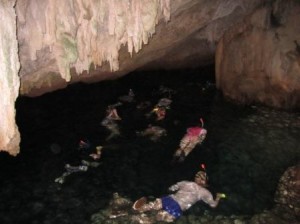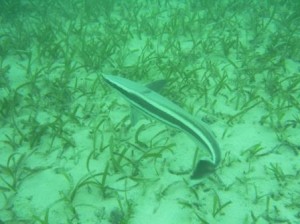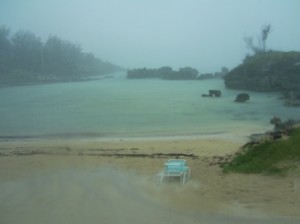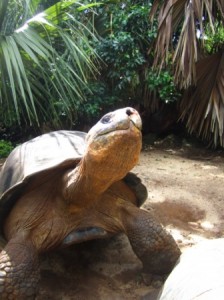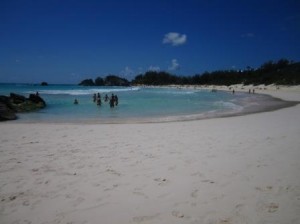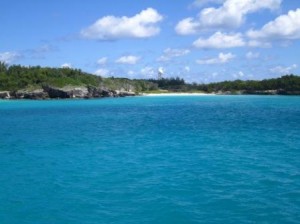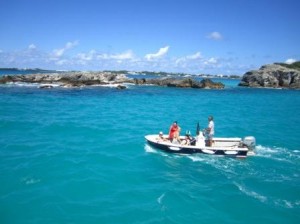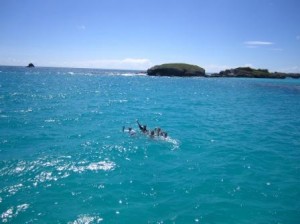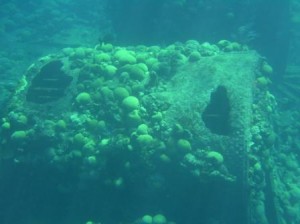Well, where to start?! Another eventful trip to the Bermuda Institute of Ocean Sciences (BIOS) is coming to an end, and as always, we’ve had a great time. Following issues with hurricanes in 2010 and 2011 we were relieved when we all got checked-in at Gatwick for the start of our trip. After a slightly bumpy landing we arrived at BIOS in time for a late dinner on Wednesday 12th September, after which the 25 students on the trip received an induction talk from the Reservations Manager, Jane Burrows. After a long journey we gave them the rest of the night off, so they were fresh and ready to start work on Thursday morning. The students first got a tour of BIOS and the opportunity to check out the amazing facilities here. They then got stuck into work with two lectures from one of the Newcastle staff, Dr Sara Marsham, taking them through coral and fish ID and introducing them to the common organisms they were likely to see on the local reefs. After a hearty lunch (there is no chance of going hungry here!) we set off to Walsingham to visit the mangrove and cave systems there. Dready was our guide and got all of the students jumping off ledges into one of the salt-water ponds in the mangroves and then led them on a snorkel through one of the large caves.
Snorkeling in Walsingham Caves
The evening saw Dr Andrew Peters give a lecture on the anatomy of Bermuda as an oceanic island and present some of the research his group have been conducting into water and air quality around the islands.
Friday was the first chance for us to get in the water and the morning saw us snorkeling a new site that we had not visited before at Bailey’s Bay. Within the Bay were the Pigeon Rocks around which was a great coral reef with lots of fish species. We saw parrot fish, butterfly fish, lizard fish and even a remora sat on the sandy floor!
A remora at Bailey’s Bay
After getting to grips with snorkelling on the reefs, Friday afternoon was planned for reef survey method development at Tobacco Bay. Unfortunately we had to abandon this plan soon after getting into the water as a huge storm came in complete with thunder, lightening and horizontal rain! Not the best conditions for laying a transect!
Sheltering from the storm at Tobacco Bay
After getting dry and warm back at BIOS, Sara along with the other member of Newcastle staff, Prof. Matt Bentley, ran a coral point count practical on Friday evening. This introduced the students to a different technique of surveying the coral cover using video transects and VLC software.
Saturday saw us take the public bus to the Bermuda Aquarium Museum and Zoo (BAMZ). This was not just a bit of fun for the students; they had to observe both the marine and terrestrial organisms in captive environments and understand the role of aquaria and zoo in conservation and management programmes. As usual there was a wide array of both marine and terrestrial organisms on display, including Sara’s favourites, the giant tortoises.
Happy after being stroked 🙂
After the aquarium and zoo we went up to the far end of the islands and visited the historic dockyards, where there is a maritime museum, Dolphin Quest and shopping malls. One of our students is an animal trainer and knew the staff at Dolphin Quest so managed to give some of the students the opportunity to swim with the dolphins!
Sunday saw us on our way to South Shore to learn about the local geology and flora from our guide, Rob Chandler. We started at Warwick Long Bay and walked along the lithified sand dunes to Horseshoe Bay. The day was scorching hot so after a quick packed lunch at Horseshore Bay we headed into the sea for a swim to cool down.
Cooling down at Horseshoe Bay
After the swim we got the public bus back to BIOS and the afternoon was spent project planning ready for project data collection after the weekend. However, before the data collection could begin, on Monday morning the students had a tour of the BIOS research vessel, the R/V Atlantic Explorer followed by a lecture on the BATS time-series data programme delivered by James Sadler.
The original plan was then to go to Nonsuch Island in the afternoon to visit an area of Bermuda that has been restored back to its native state. Most of the invasive species affecting the rest of the islands have been removed and the area has been replanted with native and endemic species. There is also a breeding programme for the endemic cahow, which is a nocturnal seabird once thought to be extinct on the islands. In 2012 there are now 101 breeding pairs using Nonsuch Island.
However, the vessel we normally use to ferry us around was out of action with a broken oil pump and the other vessel, the R/V Rumline was in use by another group. So, as is often the case with field work, plan B was initiated, which involved the project groups taking themselves off to Whalebone Bay or Tobacco Bay to start their project work. Sara and Matt stayed back at BIOS to catch up with their marking 🙁
After a successful afternoon in the water, the students had another evening lecture, this time delivered by Dr Kristen Buck that covered microbial oceanography. Every year this lecture is well received by the students and this time was no different, with them enthusing about oceanography at the end of it!
So, Tuesday morning and we headed to Nonsuch with our guide Gary, who also brought along his mother-in-law and her friend to join the group! The R/V Rumline moored just off the Island and we all swam ashore to start our adventure. Little did we know the adventure was only just beginning…
Approaching Nonsuch Island
After two hours wandering around and learning about the Island and the conservation efforts, we swam back to our vessel to start the long journey back to BIOS for a late lunch. However, the R/V Rumline had another plan in mind… Problems with the engine meant we were not going anywhere, and the only boat big enough to tow us was out taking another group on a dive. So a rescue mission was launched with three different vessels of varying size carrying passengers from five to twelve coming to take us back ashore. The students didn’t seem to mind and spent the time waiting swimming and practising their diving technique off the side of the boat. Just over three hours later, Sara, Matt and the two remaining students finally made it back to BIOS for a very late lunch (what did I say about not going hungry…?!). Thankfully George in the kitchen had saved us some food!
The first rescue mission on R/V Mussel Pie
Students making the most of the wait!
Which brings us to today… Some students continued with project work this morning by heading off to Tobacco Bay while another group went on R/V Sea Dance to the Hogbreaker reef to collect their project data at an offshore site. The rest of us? Well, thanks to J.P. Skinner we took the opportunity to take Polaris and visit another new site nine nautical miles offshore where there was the impressive wreck of the Madiana that was built in Scotland in 1877 and wrecked off of Bermuda in 1903. Both boilers and the drive shaft were clearly visible from the surface and the coral and fish abundance was stunning!
Boiler of the Madiana
This afternoon students are finishing collecting their project data at Whalebone Bay and Tobacco Bay before a coral lab tonight. Tomorrow each group will give us a presentation on their projects: what they did, why they did it, how they collected their data, and their preliminary findings before we go back to the airport and fly back to Gatwick.
Monday will see Sara and Matt back on campus in Newcastle to welcome the new Stage 1 students, with these Stage 3 students returning for their induction on Tuesday. The weather here has been good to us (apart from that afternoon at Tobacco Bay!) so we hope it is nice and sunny in Newcastle…?

